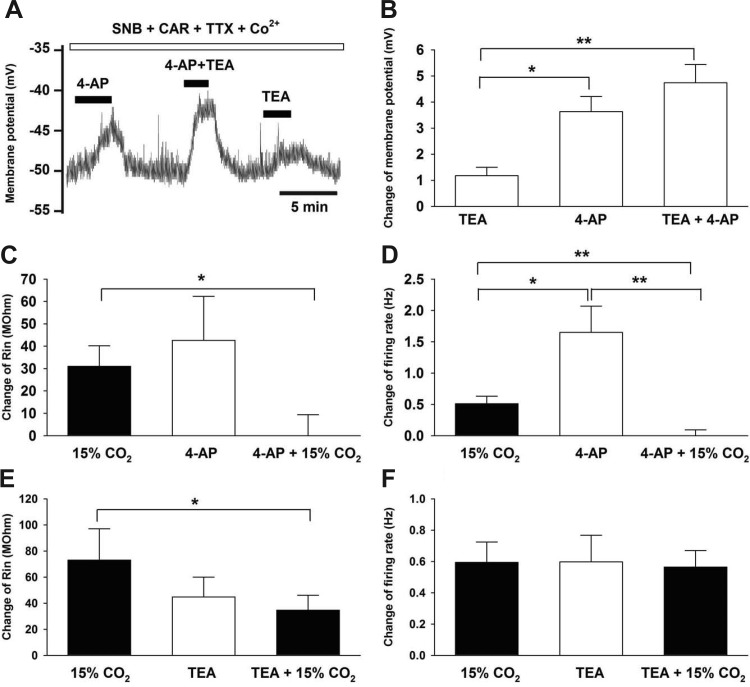Fig. 2.
The effects of TEA, 4-AP, and CO2 on the membrane potential, input resistance, and firing rate in LC neurons. A: LC neuron in the presence of synaptic blockade medium (SNB), carbenoxolone (CAR), tetrodotoxin (TTX), and Co2+, which shows no action potentials. TEA induced a small, and 4-AP induced a larger, reversible depolarization. The combination of TEA and 4-AP resulted in the largest reversible depolarization, which was the sum of the effects of each drug alone. B: summary of the effects of TEA and 4-AP on Vm. The depolarization induced by 4-AP alone and in combination with TEA was significantly larger than the depolarization induced by TEA alone. The average effects of TEA, 4-AP, and the two together on Vm are shown for 4 LC neurons (all in the presence of 5% CO2). C: effect of 15% CO2, 4-AP, and the combination of the two on the change of Rin. Rin was significantly increased by increasing CO2 from 5% to 15% and was also significantly increased by the addition of 4-AP (in the presence of 5% CO2). However, in the maintained presence of 4-AP, raising CO2 from 5% to 15% resulted in no additional increase of Rin. Thus, the increase in Rin induced by increasing CO2 from 5% to 15% in the presence of 4-AP was significantly smaller than when CO2 was increased in the absence of 4-AP. The average effects for 8 LC neurons is shown. D: effect of 15% CO2, 4-AP, and the combination of the two on the change of firing rate. The firing rate of LC neurons was significantly increased by changing CO2 from 5% to 15% and was also significantly increased by the addition of 4-AP (in the presence of 5% CO2). The addition of 4-AP alone caused a significantly greater increase in firing rate than increasing CO2 to 15%. However, in the maintained presence of 4-AP, increasing CO2 from 5% to 15% resulted in no additional increase in firing rate. Thus, the increase in firing rate induced by increasing CO2 from 5% to 15% in the presence of 4-AP was significantly smaller than when CO2 was increased in the absence of 4-AP. The average effects for 8 LC neurons is shown. E: effect of 15% CO2, TEA, and the combination of the two on the change of Rin. Rin was significantly increased by increasing CO2 from 5% to 15% and was also significantly increased by the addition of TEA (in the presence of 5% CO2). In the maintained presence of TEA, increasing CO2 from 5% to 15% resulted in a significant increase of Rin. The increase in Rin induced by increasing CO2 from 5% to 15% in the presence of TEA was significantly smaller than when CO2 was increased in the absence of TEA. The average effects for five LC neurons are shown. F: effect of 15% CO2, TEA, and the combination of the two on the change of firing rate. The firing rate was significantly increased by increasing CO2 from 5% to 15% and was also significantly increased by the addition of TEA (in the presence of 5% CO2). In the maintained presence of TEA, with the firing rate adjusted back to its initial value by injecting negative current, increasing CO2 from 5% to 15% resulted in a significant increase of firing rate. Both increasing CO2 from 5% to 15% and the addition of TEA (in 5% CO2) resulted in a significant and nearly identical increase in firing rate. Further, in the maintained presence of TEA, increasing CO2 from 5% to 15% caused a nearly identical increase in firing rate to that caused by raising CO2 in the absence of TEA. The average effects for five LC neurons is shown. In all figures, bars show means ± SE. Differences were significant at either *P < 0.05 or at **P < 0.01.

